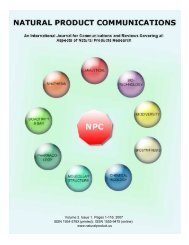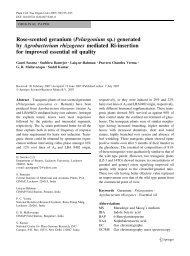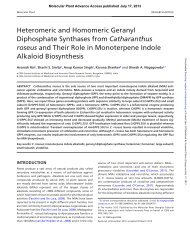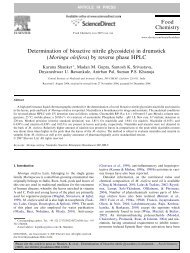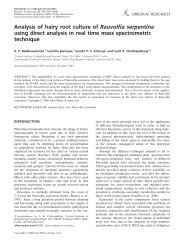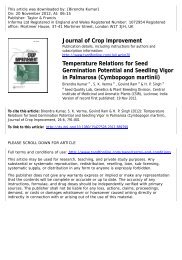Recent advances in plant hepatoprotectives - CIMAP Staff - Central ...
Recent advances in plant hepatoprotectives - CIMAP Staff - Central ...
Recent advances in plant hepatoprotectives - CIMAP Staff - Central ...
Create successful ePaper yourself
Turn your PDF publications into a flip-book with our unique Google optimized e-Paper software.
750<br />
*<br />
NEGI ET AL.<br />
hepatoprotective property aga<strong>in</strong>st wider range of liver damage <strong>in</strong>duc<strong>in</strong>g agents makes it a unique drug<br />
amongst others <strong>in</strong> the race. 34<br />
E. Toxicity and Side Effects<br />
Silymar<strong>in</strong> showed low level of toxicity with no mortality or any sign of adverse effects at oral doses of<br />
20 g/kg <strong>in</strong> mice and 1 g/kg <strong>in</strong> dogs. After <strong>in</strong>travenous <strong>in</strong>fusion its LD 50 was 400 mg/kg <strong>in</strong> mice,<br />
385 mg/kg <strong>in</strong> rats and 140 mg/kg <strong>in</strong> rabbits and dogs. 35 Although, silymar<strong>in</strong> showed a good safety<br />
record, but there are few reports of associated occurrence of gastro<strong>in</strong>test<strong>in</strong>al disturbances and allergic<br />
sk<strong>in</strong> rashes. 36,37 These data demonstrate that the acute, subacute, and chronic toxicity of silymar<strong>in</strong> is<br />
very low.<br />
F. Future Prospects<br />
Silymar<strong>in</strong> is one of the most successful examples of develop<strong>in</strong>g a modern drug from traditional<br />
<strong>in</strong>formation. However, standardization of silymar<strong>in</strong> is still lack<strong>in</strong>g <strong>in</strong> its various formulations<br />
and effective dosages. In spite of its popularity as herbal hepatoprotective drug, medical practitioners<br />
are not fully confident on its efficacy and safety parameters. Well-designed double bl<strong>in</strong>d placebocontrolled<br />
studies for specific liver disorders are necessarily required.<br />
3. ANDROGRAPHOLIDE AND NEOANDROGRAPHOLIDE<br />
A. Introduction<br />
Andrographolide (4) and neoandrographolide (5) are obta<strong>in</strong>ed from Andrographis paniculata Nees<br />
(Family: Acanthaceae), a well known <strong>plant</strong> for liver diseases. 38 The <strong>plant</strong> is basically orig<strong>in</strong>ated from<br />
south-east Asia and commonly called; Chuan x<strong>in</strong> lian <strong>in</strong> Ch<strong>in</strong>a, Kalmegh and Bhunimba <strong>in</strong> India,<br />
Hempedubumi <strong>in</strong> Malaysia, etc. The <strong>plant</strong> is also known as ‘‘k<strong>in</strong>g of bitters’’ due to its bitterness. The<br />
hepatoprotective activity of andrographolide is well established 39–41 and other constituents (Fig. 3)<br />
of the <strong>plant</strong> like neoandrographolide (5), andrographoside (6), and andrograpan<strong>in</strong> (7) also showed<br />
significant activity aga<strong>in</strong>st various types of liver damages.<br />
B. Chemistry<br />
Bioguided phytochemical <strong>in</strong>vestigation of A. paniculata yielded andrographolide as the ma<strong>in</strong><br />
hepatoprotective pr<strong>in</strong>ciple. 42 Chemically, andrographolide (4) is a labdane diterpene lactone named<br />
as, 3-[2-{decahydro-6-hydroxy-5-(hydroxymethyl)-5,8a-dimethyl-2-methylene-1-naphthalenyl}<br />
ethylidene]dihydro-4-hydroxy, 2(3H)-furanone. It is present <strong>in</strong> all parts of the <strong>plant</strong> and maximum<br />
<strong>in</strong> leaves (over 2%). Its structure and stereochemistry were fully established. 43,44 Various techniques<br />
have been developed to separate and determ<strong>in</strong>e andrographolide <strong>in</strong> the <strong>plant</strong> extract. 45–49<br />
C. Biological Activity<br />
Methanolic extract of A. paniculata showed 32% recovery <strong>in</strong> CCl 4 <strong>in</strong>duced liver damage <strong>in</strong> rats. 50<br />
Andrographolide exhibited protective effects comparable to that of silymar<strong>in</strong> aga<strong>in</strong>st liver damage <strong>in</strong><br />
rats <strong>in</strong>duced by carbon tetrachloride, paracetamol, galactosam<strong>in</strong>e and t-butylhydroperoxide. 39–41<br />
The protective effect of the leaf extract aga<strong>in</strong>st carbon tetrachloride <strong>in</strong>duced hepatotoxicity was<br />
found more significant than that of andrographolide. 51 Whereas andrographolide was found more<br />
potent than silymar<strong>in</strong> aga<strong>in</strong>st paracetamol <strong>in</strong>duced damage of hepatocytes. It normalizes the elevated<br />
levels of certa<strong>in</strong> enzymes (GOT, GPT, and alkal<strong>in</strong>e phosphatase) <strong>in</strong>duced by paracetamol <strong>in</strong> serum as<br />
well as <strong>in</strong> isolated hepatic cells. 52 Andrographolide and neoandrographolide had significant<br />
antihepatotoxic effect aga<strong>in</strong>st Plasmodium berghei K173-<strong>in</strong>duced hepatic damage of Mastomys<br />
Medic<strong>in</strong>al Research Reviews DOI 10.1002/med




